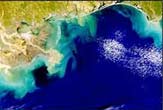Gulf's 'Dead Zone' Less of a Mystery

HOUSTON (AP) -- The oxygen-depleted "dead zone" in the Gulf of Mexico, long a subject of scrutiny by scientists, is only now becoming less of a mystery.
Known by fishermen south of the Mississippi River for more than a century, the area gained scientific recognition in the 1970s but became a greater concern when it doubled in size to about 7,000 square miles about 20 years later.
That expansion was blamed on nitrates, which are used as fertilizer and wash into the Mississippi River. The excess nitrates created large phytoplankton blooms, scientists said. Bacteria that thrive on the plankton after it dies consume more and more oxygen and the lower-oxygen water settles to the bottom.
The result, says Texas A&M University oceanographer Steven DiMarco, is a stable water column where the bottom 10 to 20 percent doesn't get replenished with fresh oxygen.
DiMarco said that this dead-zone effect is most persistent in the summer months, when the Gulf of Mexico waters are stagnant and there is little mixing. Fronts that develop by September help break up the dead zone by stirring up the Gulf waters.
When DiMarco's research team went to sea in late August, he was surprised at the finding.
"The dead zone, which had been measured just three weeks before, had broken up," he told the Houston Chronicle in Tuesday's editions.
Get the world’s most fascinating discoveries delivered straight to your inbox.
But DiMarco said the decline can't be explained by the active hurricane season, because the researchers visited before Frances and Ivan hit the area, and Bonnie and Charley were peripheral to the dead zone.
Scientists now believe other factors play a major role in the dead zone's growth, including the coastal current which usually flows from Louisiana to Texas from September through May.
A "dead zone" occurs in the Gulf of Mexico each summer as nutrient build-upleads to drastic reductions in oxygen in bottom waters. Fish and shrimp catches virtually disappear. Image Credit: NASA
DiMarco said winds reverse in June and the general circulation moves waters from Texas up to Louisiana. This may help block fresh, oxygen-rich water from reaching the dead zone. He said the coastal flow this year had switched course back from Louisiana to Texas earlier, in August, about the same time as the dead zone began breaking up.
"We know it's a seasonal phenomenon, but there are random processes at work that can make it bigger or smaller," said DiMarco, who will continue his research funded by the National Oceanic and Atmospheric Administration next year. "We know it's a seasonal phenomenon, but there are random processes at work that can make it bigger or smaller.
"It's gone for this year, but I certainly expect it to be back next year," he said.


